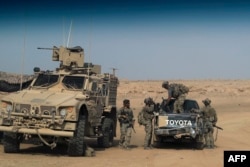U.S.-backed forces in Syria are pushing further into Islamic State's last stronghold along the Syria-Iraq border, forcing their way into the town of Hajin within the past two days.
The area has seen some intense back-and-forth battles between IS fighters and Syrian Democratic Forces over the past several weeks, with IS briefly regaining territory before being pushed back.
But U.S. officials are expressing hope that the recent advance by coalition-backed forces into Hajin is a sign of things to come.
"That's a pretty significant achievement," Brett McGurk, special presidential envoy for the Global Coalition to Defeat ISIS, told reporters at the State Department on Tuesday, cautioning that retaking the entire IS enclave could still take a "period of months."
"There is a significant concentration of the most hardened ISIS fighters in that little splotch of territory," he said, using an acronym for the terror group. "A couple of thousand hardened fighters remain in that area."
Syrian Democratic Forces, with the help of coalition air support and some U.S. troops on the ground, have been battling IS fighters in Hajin and the Deir el-Zour countryside in Syria since August, part of what's been called Phase Three of Operation Roundup.
Multiple U.S. and coalition officials have described the fighting as difficult, citing the experience of the IS fighters in the area, the prevalence of improvised explosive devices and booby traps, as well as the willingness of IS to use human shields.
On Monday, the U.S.-led coalition charged IS fighters were using Hajin hospital as a base to attack partner forces.
"By these actions, ISIS caused the hospital to lose its protected status afforded by the Law of Armed Conflict by using a facility otherwise protected under the Geneva Conventions," the coalition said in a statement.
Civilians have also been fleeing the area seeking safety.
McGurk said about 1,400 civilians have fled Hajin in the past week alone, and that some were being cared for by the coalition-backed forces on the ground.
He warned that even after the area is retaken from IS, the fight will not be over.
"There are clandestine cells," McGurk said. "No one is saying they are going to disappear. Nobody is that naive."
One of the key questions for the U.S.-led coalition is determining the size and scope of IS cells in areas that the terror group no longer controls but from which it has managed to mount a persistent insurgency.
A report in August by the lead inspector general for Operation Inherent Resolve, based on the Pentagon's own internal estimates, said IS had 28,000 to 32,000 fighters under its command, roughly split between Iraq and Syria.
Pentagon officials have also voiced concerns that IS "is well-positioned to rebuild and work on enabling its physical caliphate to re-emerge."
In Iraq, where political leaders declared victory over IS over a year ago and the overall number of attacks has dropped, terror cells have increased the number of attacks against government targets.
75 per month
According to a recent report from the Center for Strategic and International Studies, IS has been averaging 75 attacks a month. In areas like Kirkuk province, the number of attacks has actually doubled.
U.S. officials say in Kirkuk, and Hawijah in particular, Iraqi federal police have responded with "large-scale clearance operations, targeting IS remnants hiding in the mountains."
"ISIS itself really right now is in austere conditions," Col. Jonathan Byrom, commander of Joint Operations Command-Iraq, said Tuesday.
"They are spending most of their time in caves, underground in tunnels," he said. "Security forces are continuing to move into those areas to hunt them down."
Neither Byrom nor McGurk was willing to address how many IS adherents remain in Iraq or Syria, willing to fight now or biding their time to strike at a more opportune moment.
"I just try to stay away from numbers," McGurk said Tuesday, noting estimates have varied greatly.
"It's not numbers. It's capabilities," he added. "The degradation of ISIS' capability to be able to mass, maneuver forces, to be able to do what it used to be able to do, is significantly degraded."









